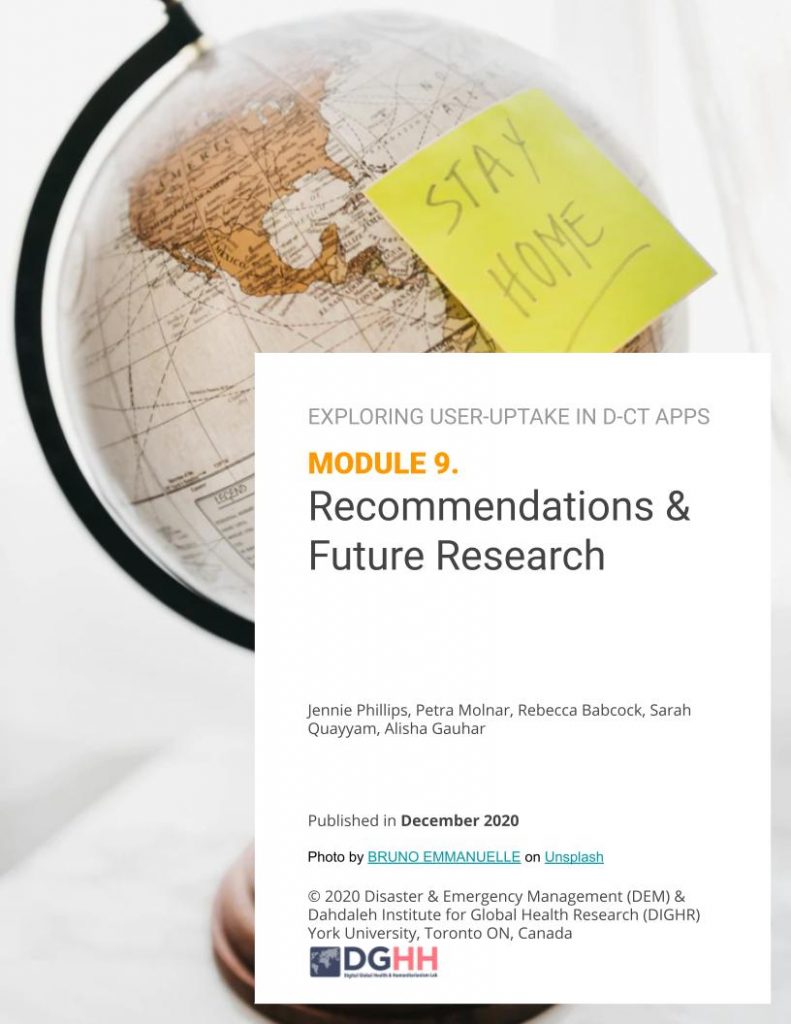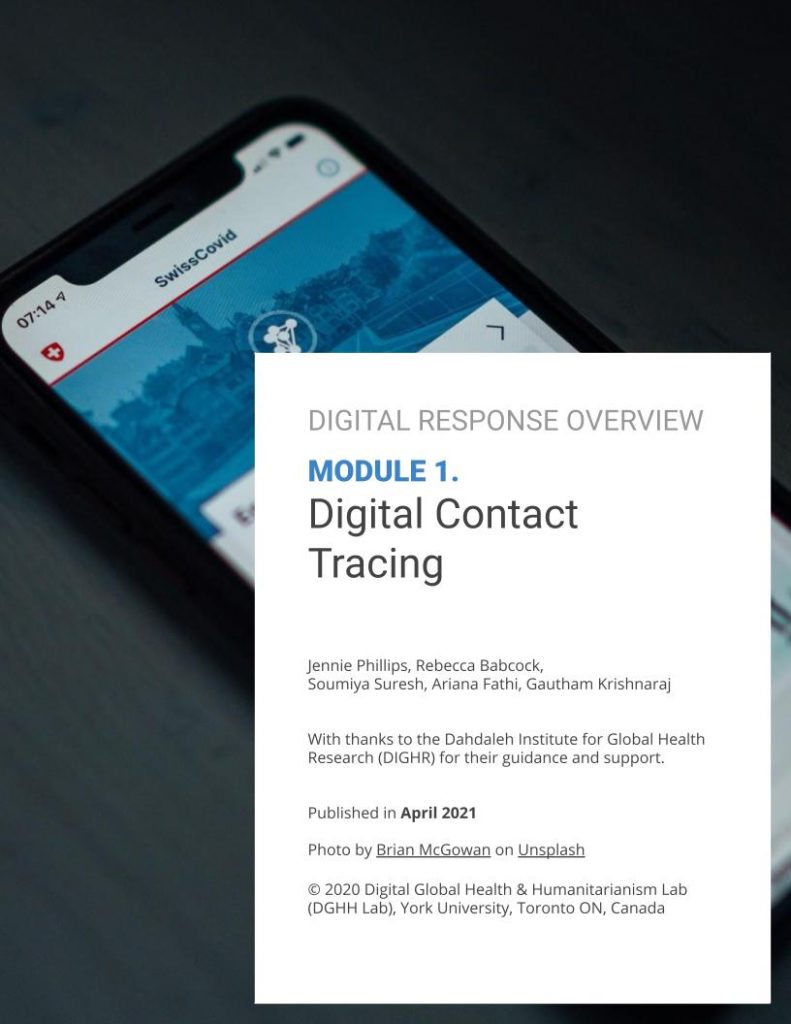Publications
Our publications fall under the following major projects, consisting of individual modules published as standalone practitioner guides and reports.
The digital response to COVID-19: Exploring the use of digital technology for information collection, dissemination, and social control in a global pandemic. (Peer-Reviewed Article, Journal of Business Continuity & Emergency Planning)

Abstract: In response to the COVID-19 pandemic, there has been a global surge in the development and implementation of digital interventions to diagnose, track, prevent and mitigate the spread of the SARS-CoV-2 coronavirus. To date, however, there has been little research to characterise the vast scope and scale of these novel, ad hoc and widely varied digital tools. This paper helps fill this gap by providing a descriptive summary of the digital response to COVID-19. The research finds that the digital response can be broken into four main catego- ries: 1) tracking the spread of the virus (contact tracing); 2) controlling social behaviour during the outbreak (social behaviour monitoring); 3) information gathering and dissemination about the virus (one-way and two-way public com- munications); and 4) diagnosis and treatment (remote diagnostics and treatment). This paper describes the four response categories and pro- vides examples of the digital technologies being developed and implemented for these purposes. This descriptive understanding provides a con- textual foundation for subsequent research to analyse the opportunities and challenges asso- ciated with the development, implementation and uptake of digital interventions, alongside the development of analytical frameworks and guidance.
Exploring User-Uptake of Digital Contact Tracing Apps: A Practitioner Guide

Practitioner Guide
This Practitioner Guide consists of Modules 1-9 – the Primer; the five case studies (Iceland, Cyprus, Ireland, Scotland, & South Africa); individual, community, and system level factor analysis of factors impacting user-uptake; and recommendations & future research – plus the Methodology

Executive Summary
A brief summary of the study, its findings, and the research team’s 23 recommendations to improving user uptake of D-CT apps.
Special Edition. Case Study, Canada (Module 10)
This Module explores the micro-, meso-, and macro-level factors influencing digital contact tracing in Canada, examining all eight factors identified in the other case studies plus a ninth factor specific to Canada — Provincial & Territorial Support.

Module 1. Digital Contact Tracing (D-CT) and User-Uptake: A Primer
This Module introduces readers to digital contact tracing and the concept of user-engagement and user-uptake in relation to digital contact tracing apps.

Module 2. Case Study, Iceland
This Module explores the micro-, meso-, and macro-level factors influencing digital contact tracing in Iceland, including sense of community, public trust, policy and governance, and response infrastructure.

Module 3. Case Study, Cyprus
This Module explores the micro- and macro-level factors influencing digital contact tracing user-uptake in Cyprus, including perceptions of data collection, public trust, policy, and digital capability.

Module 4. Case Study, Ireland
This Module explores the micro-, meso-, and macro-level factors influencing digital contact tracing user-uptake in Ireland, including public perceptions, sense of community, misinformation, accessibility and inclusion, and public trust.

Module 5. Case Study, Scotland
This Module explores the micro-, meso-marco, and macro-level factors influencing digital contact tracing user-uptake in Scotland, including perceptions of data collection, communications & misinformation, accessibility & inclusion, public trust, and digital capability.

Module 6. Case Study, South Africa
This Module explores the meso-macro and macro-level factors influencing digital contact tracing user-uptake in South Africa, including communications & misinformation, accessibility & inclusion, public trust, and response infrastructure

Module 7. Analysis of User-Uptake Factors: Individual- & Community-Level Influences
This module aims to explore the individual- and community-level factors identified in our research in more depth through comparative analysis across case studies. We explore three factors – 1) Perceptions of Data Collection & Management; 2) Sense of Community; and 3) Communications & Misinformation – identified as potential influencers of app-uptake at the individual (micro) and community (meso) levels as well as at the intersection of the community-system (meso-macro) levels.

Module 8. Analysis of User-Uptake Factors: System-Level Influences
This module aims to explore the system-level factors identified in our research in more depth through comparative analysis across case studies. We explore five factors – 1) Accessibility & Inclusion; 2) Trust in Public/Private Institutions; 3) Policy & Governance; 4) Response Infrastructure; and 5) Digital Capability – identified as potential influencers of app-uptake at the system (macro) level.

Module 9. Recommendations & Future Research
This module aims to provide high-level recommendations for implementers ranging from decision-makers in government to app developers to humanitarian responders on reasons why app-uptake may vary across contexts and how risks versus benefits should be considered in efforts to enhance uptake. Second, this module aims to identify areas of future research that are worth pursuing to gain more understanding of the risks and benefits towards users. Recommendations are provided through five main challenges identified in the research which are linked to user-uptake.
Digital Response to COVID-19: Exploring digital interventions used by governments to monitor, support and control the public response to the pandemic

The Digital Response to COVID-19
The Digital Response to COVID-19 report consists of Modules 1-3 – Digital Contact Tracing; Social Behaviour Monitoring; and Public Communications and Remote Diagnostics & Treatment.

Module 1. Digital Contact Tracing
This module of the Digital Response to COVID-19 Study focuses specifically on digital measures used to track the spread of the virus (digital contact tracing) during the COVID-19 pandemic. Digital contact tracing (D-CT) is introduced by explaining the concept of contact tracing, how D-CT differs from in-person or manual contact tracing (M-CT), and then how D-CT works through description of the various digital technologies in use. Applications of D-CT interventions are described through three main approaches: centralized tracing – enforced, centralized tracing – voluntary, and decentralized tracing – involuntary.

Module 2. Social Behaviour Monitoring
This module of the Digital Response to COVID-19 Study focuses specifically on digital measures used to monitor and control social behaviours during the coronavirus outbreak during the COVID-19 pandemic. Social behaviour monitoring is introduced by explaining the concept as applied to COVID-19, and the need for digital intervention. Applications of social behaviour monitoring are described through three main approaches: quarantine monitoring, social distancing and other public health measures enforcement, and informing future planning & policy.

Module 3. Public Communications and Remote Diagnostics & Treatment
This module of the Digital Response to COVID-19 Study focuses specifically on digital measures used to enable public communications as well as remote diagnostics and treatment during the COVID-19 pandemic. Public communications are introduced through a comparison of traditional and emergent forms of communications. Applications of digital technology use for public communications are explained through two main approaches: one-way and two-way communications. Remote diagnostics and treatment tools are introduced by explaining both concepts and distinguishing how diagnosis and treatment are typically performed from how they have been performed during the pandemic. Applications of remote diagnostics and treatment tools are described through three main approaches: screening and assessment, healthcare delivery, and decision-making and research support.
Opinion Editorials:
Beyond contact tracing: The opportunities and challenges of digital responses to COVID-19
First Policy Response



